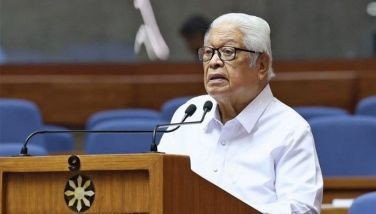Fanal, Coyuito-Sunico in compelling concert of French compositions
January 17, 2004 | 12:00am
A fascinating and compellilng program, culled from the repertoire of French conductor Dominique Fanal, consisted understandably of French music at a concert presented by the CCP with the cooperation, again understandably, of the French Embassy headed by Ambassador Renée Veyret.
Conductor-pianist-composer Fanal, 47, has won several awards, among them four first prizes from the Paris Conservatory. He conducts the Sinfonietta de Paris, which gives 40 to 50 annual concerts in France and abroad, and many foreign orchestras including London’s St. Martin-in-the Fields (which performed at the CCP years ago), and others in Europe, the US, Russia, Mexico and Latin American.
Wielding the baton over the Philippine Philharmonic Orchestra (PPO), Fanal opened the concert with Berlioz’s Beatriz et Benedict Overture. Berlioz is far less often heard than Liszt, Brahms, Verdi or Tchaikovsky. Nevertheless, Fanal’s rendition of the overture eloquently foisted its beauty and balanced orchestration on the listeners.
On the podium, Fanal was totally focused on the score. With not the slightest tendency toward exhibitionism (grandstanding), he conducted in a straightforward, earnest and vigorous manner while drawing the desired result from each orchestral section.
Poulenc, a member of The French Six (Le Six), wrote his Concerto in D Minor for Two Pianos and Orchestra in his characteristicically witty and satiric vein. Sparkling melodic lines are interspersed with strong, propulsive rhythms which infuse into the piece a highly percussive quality.
Cristine Coyuito on the first piano and Raul Sunico on the second seemed to be vastly enjoying themselves, with Coyuito’s runs gliding smoothly and gracefully against Sunico’s powerful, formidable chords.
Brilliant interplay existed throughout between the two pianos, from the first to the second theme in the allegro ma non troppo movement, the second theme being introduced by the woodwinds and solo horn. In the larghetto, the first piano announces the theme through a melody, with the second piano repeating it. The concerto then closes in a fervid outburst of sound from the orchestra and the two pianos after the closest ensemble work or "togetherness" with both pianists pointing up Poulenc’s piquant charm spiritedly and spontaneously. It was great fun listening to the interaction between the two pianists and between them and the conductor.
Milhaud, another member of The French Six, composed Le Boeuf sur le Toit (The Cow on the Roof), a title which connotes to virtually every Frenchman jazz music. The composition is for a pantomine or farce, the title actually alluding to The Nothing-Doing Bar, an American speakeasy with assorted American characters.
Milhaud briefly served as attaché in the French legation in Brazil, and inevitably, Le Boeuf became heavily influenced by Brazilian music – its recognizable tangos, sambas and other Latin American tunes.
Fanal injected into his rendition the zest and zeal the music demanded, its dance rhythms and character remaining unmistakable – and infectious.
In Gounod’s ballet music Walpurgis Night from the opera Faust, light alternated with shade, the dramatic with the lyrical in the various dances – an integral part of the opera – while evoking myths, fantasies, magic spells and nights of splendor.
Ravel’s, Bolero was a feat not only of orchestration but also of interpretation.
With only a single theme and a counter-subject repeated over and over again throughout the piece in bolero rhythm, with no development or variation or change of tempo, the work opens with a lone flute playing the single theme.
Later, another wind instrument joins, and still another; cellos begin to be plucked; violins, too, then the entire string section slowly plays with the bow. The winds and brasses keep joining and growing in numbers while the snare drum gives the same rhythmic beat from start to finish. The augmentation of sound continues relentlessly until the orchestra, performing tutti, reaches a tremendous, overpowering climax.
Bolero had been commissioned by Ida Rubinstein who danced to it at the Paris Opera in 1928. The following year, Arturo Toscanini, directing the NY Philharmonic, introduced the novel, electrifying tour de force thus creating a sensation.
Fanal generated his own kind of excitement by wringing maximum effort and energy from each instrumentalist to produce utmost tonal intensity. Although the PPO is much smaller than the NY Philharmonic, under Fanal’s baton it left a thunderous impact on the audience. What a magnificent ending to a splendid concert!
Gratified with the orchestral performance, Fanal asked the members of each section to stand up and take a bow, then beckoned to the snare drummer to come down and be recognized. Applause for Maestro Fanal was deservedly lusty and prolonged.
Tonight at 8, young Rodel Colmenar conducts the Manila Philharmonic Orchestra at the Philamlife auditorium in The Three-Cornered Hat by De Falla, Philippin Portraits by R. Romero, and Lalo’s Concerto in F Major with Rumanian violinist Alexander Tomescu as featured soloist.
On, Jan. 21, Tomescu will give a solo recital, also at 8 p.m. in the same venue.
Janet Seidel will conduct a jazz master-class on Jan. 28 at the UST Conservatory, and on Jan. 29 at the UP College of Music, both at 3 p.m. Her jazz concert will be on Jan. 28, 6:30 p.m. at the Podium, Ortigas Center.
Conductor-pianist-composer Fanal, 47, has won several awards, among them four first prizes from the Paris Conservatory. He conducts the Sinfonietta de Paris, which gives 40 to 50 annual concerts in France and abroad, and many foreign orchestras including London’s St. Martin-in-the Fields (which performed at the CCP years ago), and others in Europe, the US, Russia, Mexico and Latin American.
Wielding the baton over the Philippine Philharmonic Orchestra (PPO), Fanal opened the concert with Berlioz’s Beatriz et Benedict Overture. Berlioz is far less often heard than Liszt, Brahms, Verdi or Tchaikovsky. Nevertheless, Fanal’s rendition of the overture eloquently foisted its beauty and balanced orchestration on the listeners.
On the podium, Fanal was totally focused on the score. With not the slightest tendency toward exhibitionism (grandstanding), he conducted in a straightforward, earnest and vigorous manner while drawing the desired result from each orchestral section.
Poulenc, a member of The French Six (Le Six), wrote his Concerto in D Minor for Two Pianos and Orchestra in his characteristicically witty and satiric vein. Sparkling melodic lines are interspersed with strong, propulsive rhythms which infuse into the piece a highly percussive quality.
Cristine Coyuito on the first piano and Raul Sunico on the second seemed to be vastly enjoying themselves, with Coyuito’s runs gliding smoothly and gracefully against Sunico’s powerful, formidable chords.
Brilliant interplay existed throughout between the two pianos, from the first to the second theme in the allegro ma non troppo movement, the second theme being introduced by the woodwinds and solo horn. In the larghetto, the first piano announces the theme through a melody, with the second piano repeating it. The concerto then closes in a fervid outburst of sound from the orchestra and the two pianos after the closest ensemble work or "togetherness" with both pianists pointing up Poulenc’s piquant charm spiritedly and spontaneously. It was great fun listening to the interaction between the two pianists and between them and the conductor.
Milhaud, another member of The French Six, composed Le Boeuf sur le Toit (The Cow on the Roof), a title which connotes to virtually every Frenchman jazz music. The composition is for a pantomine or farce, the title actually alluding to The Nothing-Doing Bar, an American speakeasy with assorted American characters.
Milhaud briefly served as attaché in the French legation in Brazil, and inevitably, Le Boeuf became heavily influenced by Brazilian music – its recognizable tangos, sambas and other Latin American tunes.
Fanal injected into his rendition the zest and zeal the music demanded, its dance rhythms and character remaining unmistakable – and infectious.
In Gounod’s ballet music Walpurgis Night from the opera Faust, light alternated with shade, the dramatic with the lyrical in the various dances – an integral part of the opera – while evoking myths, fantasies, magic spells and nights of splendor.
Ravel’s, Bolero was a feat not only of orchestration but also of interpretation.
With only a single theme and a counter-subject repeated over and over again throughout the piece in bolero rhythm, with no development or variation or change of tempo, the work opens with a lone flute playing the single theme.
Later, another wind instrument joins, and still another; cellos begin to be plucked; violins, too, then the entire string section slowly plays with the bow. The winds and brasses keep joining and growing in numbers while the snare drum gives the same rhythmic beat from start to finish. The augmentation of sound continues relentlessly until the orchestra, performing tutti, reaches a tremendous, overpowering climax.
Bolero had been commissioned by Ida Rubinstein who danced to it at the Paris Opera in 1928. The following year, Arturo Toscanini, directing the NY Philharmonic, introduced the novel, electrifying tour de force thus creating a sensation.
Fanal generated his own kind of excitement by wringing maximum effort and energy from each instrumentalist to produce utmost tonal intensity. Although the PPO is much smaller than the NY Philharmonic, under Fanal’s baton it left a thunderous impact on the audience. What a magnificent ending to a splendid concert!
Gratified with the orchestral performance, Fanal asked the members of each section to stand up and take a bow, then beckoned to the snare drummer to come down and be recognized. Applause for Maestro Fanal was deservedly lusty and prolonged.
Tonight at 8, young Rodel Colmenar conducts the Manila Philharmonic Orchestra at the Philamlife auditorium in The Three-Cornered Hat by De Falla, Philippin Portraits by R. Romero, and Lalo’s Concerto in F Major with Rumanian violinist Alexander Tomescu as featured soloist.
On, Jan. 21, Tomescu will give a solo recital, also at 8 p.m. in the same venue.
Janet Seidel will conduct a jazz master-class on Jan. 28 at the UST Conservatory, and on Jan. 29 at the UP College of Music, both at 3 p.m. Her jazz concert will be on Jan. 28, 6:30 p.m. at the Podium, Ortigas Center.
BrandSpace Articles
<
>
- Latest
- Trending
Trending
Latest
Trending

By COMMONSENSE | By Marichu A. Villanueva | 2 days ago

By VIRTUAL REALITY | By Tony Lopez | 1 day ago
Latest
Recommended

January 30, 2025 - 6:03pm


























